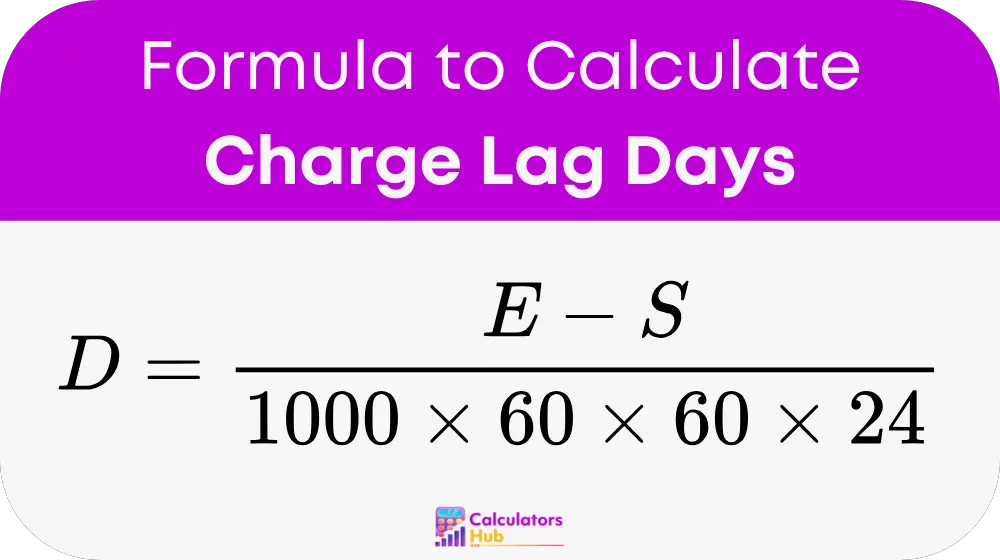The Charge Lag Days Calculator is an essential tool for calculating the number of days between two important events: the Charge Entry Date and the Service Date. It is used to determine the delay or gap in time between when a charge is entered into a system and when the service or event corresponding to that charge actually occurs.
This type of calculation is vital in a wide range of industries. For example, it’s particularly useful in billing systems, where companies need to track the delay between a transaction and when a service is delivered. Similarly, in logistics and supply chain management, this tool can help track the time between when an order is placed and when it is fulfilled.
In many financial and business processes, understanding charge lag days helps improve operational efficiency, predict cash flow, and enhance customer experience by providing more accurate timelines for service delivery or payment processing.
Formula for Charge Lag Days Calculation
To calculate the number of Charge Lag Days, you can use the following formula:

Where:
- D = Charge Lag Days (the total number of days between the Charge Entry Date and the Service Date).
- E = Date of Charge Entry (in milliseconds since the epoch or Unix timestamp).
- S = Date of Service (in milliseconds since the epoch or Unix timestamp).
- 1000 × 60 × 60 × 24 = Conversion factor to convert the difference between the two timestamps from milliseconds into days.
Breaking down the formula:
- Milliseconds (ms) are the most precise unit of time used in computers to represent time.
- By subtracting the service date from the charge entry date (both in milliseconds), we get the difference in time.
- The result is divided by the number of milliseconds in one day (1000 ms/sec × 60 sec/min × 60 min/hour × 24 hours/day), which converts the time difference into days.
General Terms Related to Charge Lag
To ensure clarity and ease of understanding, here is a table of commonly searched terms and concepts related to Charge Lag, Timestamps, and Time Calculations:
| Term | Definition |
|---|---|
| Charge Lag Days (D) | The number of days between the date a charge is entered and the date the service is provided. |
| Unix Timestamp | A system for tracking time, representing the number of milliseconds since January 1, 1970 (known as the Unix epoch). |
| Epoch | The starting point for the Unix timestamp system, typically January 1, 1970. |
| Milliseconds (ms) | A unit of time; one millisecond is one-thousandth of a second. |
| Service Date (S) | The date when the service associated with a charge is provided. |
| Charge Entry Date (E) | The date when the charge is entered or recorded in the system. |
| Time Conversion | The process of converting time between different units (e.g., milliseconds to days). |
| Time Lag | The delay between two time events, such as between charge entry and service delivery. |
Example Calculation
To help visualize how the Charge Lag Days Calculator works, let's go through a practical example:
Scenario:
- A charge entry was made on March 1st, 2024, at 12:00 PM.
- The service was provided on March 5th, 2024, at 12:00 PM.
Step 1: Convert the dates to Unix timestamps (in milliseconds since the epoch). For simplicity, let’s assume the Unix timestamps for these two dates are:
- Charge Entry Date (E) = 1709337600000 ms (March 1st, 2024, 12:00 PM)
- Service Date (S) = 1709692800000 ms (March 5th, 2024, 12:00 PM)
Step 2: Use the formula:
D = (E − S) / (1000 × 60 × 60 × 24)
Substitute the values:
D = (1709692800000 − 1709337600000) / (1000 × 60 × 60 × 24)
D = 3552000000 / 86400000 = 41.14 days
In this example, the charge lag is approximately 4 days.
Most Common FAQs
Charge Lag refers to the delay or gap in time between when a charge is enter into a system (the Charge Entry Date) and when the corresponding service is provided (the Service Date). This time gap is measure in days and is useful for tracking the efficiency and timeliness of service delivery or billing processes.
The Charge Lag Days Calculator helps businesses track delays in billing and service delivery, allowing them to improve operational efficiency and manage customer expectations. It is useful in industries like finance, logistics, and customer service to monitor how long it takes for a service to be provide after a charge is enter into the system.
Yes, the Charge Lag Days Calculator is commonly use in billing systems to track the number of days between when a charge is log and when the associated service is render. This helps businesses manage their invoicing cycles and ensure timely service delivery.